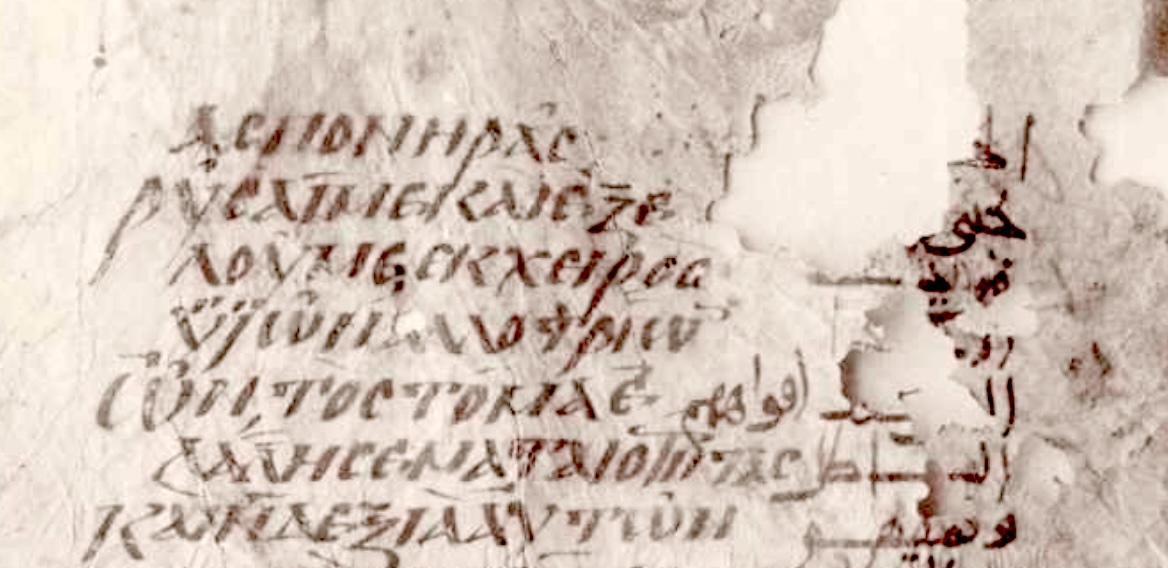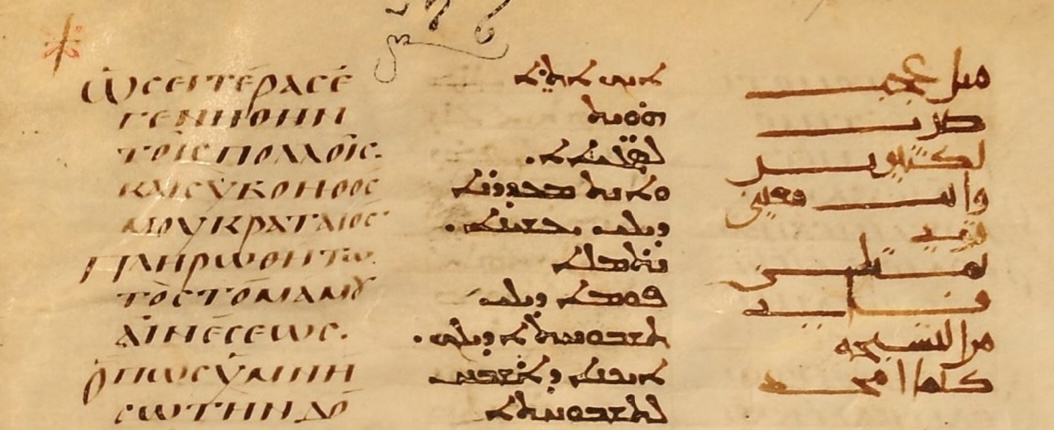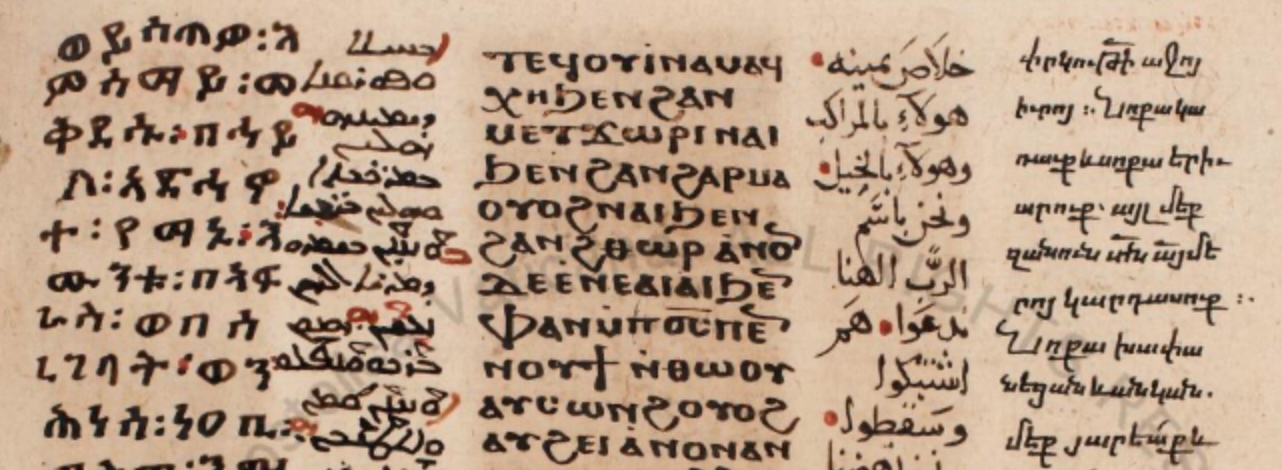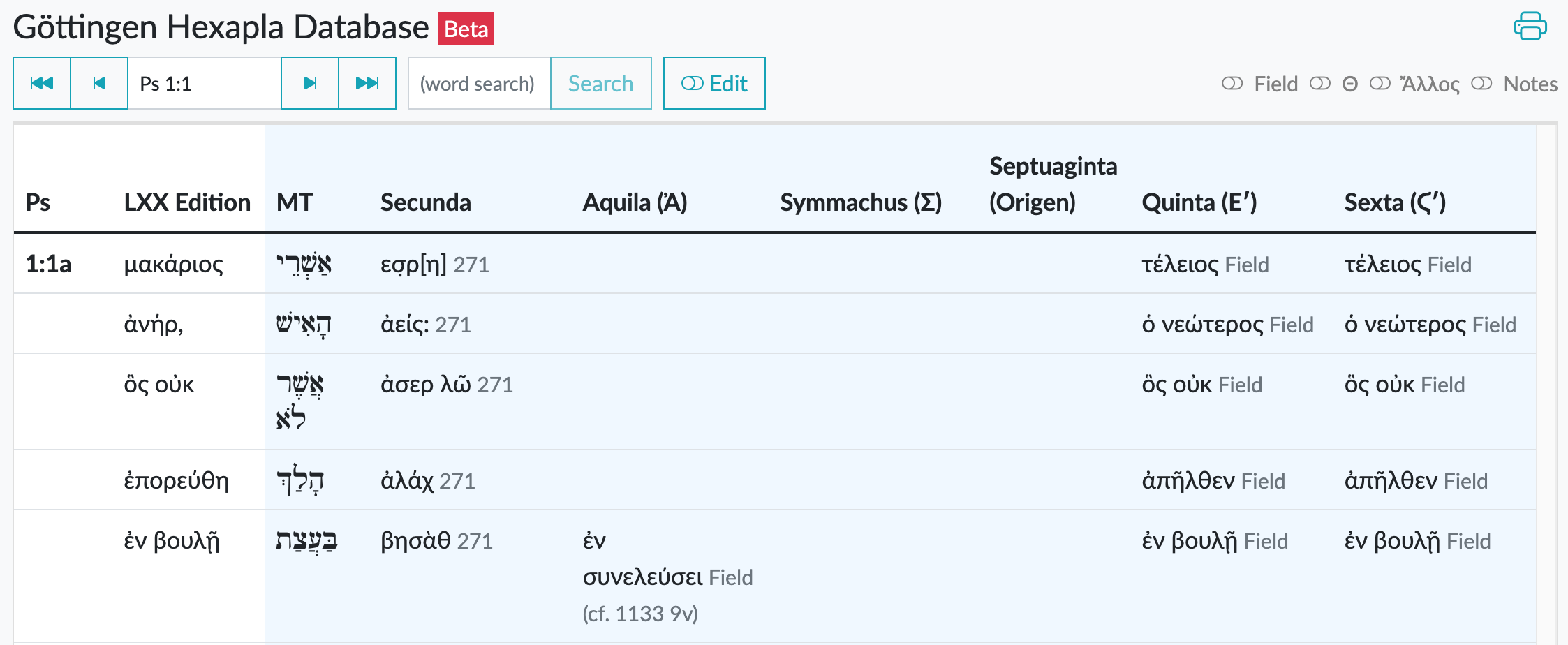
Psalter Polyglots: Echoes of Ancient Tongues
Felix Albrecht
January 31, 2024
The subject of this brief contribution is an overview of the Psalter Polyglots. These manuscripts represent a fascinating phenomenon in the transmission of biblical texts and vividly illustrate the cultural interplay between different textual traditions. They also illustrate the significance and position of the Greek Psalter within the chorus of Psalter translations. Guidance on this tradition is provided by Detlef Fraenkel’s overview.[1], which is supplemented by further examples below.
Origen’s six-column Hexapla is the earliest example of a multilingual edition of the Psalter. In addition to the Greek text tradition distributed over four columns, it also contained the Hebrew tradition in two columns: the Hebrew consonant text in Hebrew script and the vocalised Hebrew text in Greek transliteration.[2] An ongoing reconstruction of the Psalms Hexapla can be accessed through our Göttingen Hexapla Database.
Within the multilingual tradition, the Greek-Latin manuscripts hold great significance. These include the classical Greek-Latin bilinguals, such as Ra 188 from the seventh century, as well as those manuscripts that represent the Greek text in Latin characters. The most notable example of this is the sixth-century Verona Psalter (Ra R). The text arrangement in this manuscript is particularly interesting, with the Greek text in Latin transliteration on the left hand (verso), and the Latin text on the right hand (recto).[3] Equally fascinating are the Psalteria Quadruplicia. These offer the Psalter text in four columns: the three Latin versions – Gallicanum, Romanum, and Hebraicum – alongside the Greek Psalter text in Latin letters. The oldest example of this is the Bamberg Psalter, dating back to the year 909 (Ra 1037).
The tradition of Greek-Coptic bilingual manuscripts is also ancient and significant. Four remarkable Greek-Sahidic bilinguals are particularly worth mentioning:[4] From the fourth century, there is Ra 1220, a fragmentary papyrus codex containing a Greek-Sahidic Psalter. The text sequence alternates between Greek and Coptic, with each Greek Psalm followed by its Coptic counterpart, all written in a single column. I have dated this manuscript to the fourth century AD. Twenty-five fragmented leaves of this manuscript are preserved, now housed under various signatures in the Papyrus Collection of the Austrian National Library in Vienna. This manuscript is unique in its construction, as it consists of bifolia that are merely sewn together and not interleaved. Another significant bilingual Psalter from the fifth to sixth century AD is Ra 2015, a parchment codex with a Greek-Sahidic Psalter from the White Monastery.[5] The text sequence here is parallel Greek and Coptic, written in a single column.[6] The third Greek-Sahidic bilingual (Ra 2032), dates from the tenth to eleventh century, though its dating is highly disputed. This is a fragmentary parchment codex containing a Greek-Sahidic lectionary for the Psalms and Gospels. The text is arranged in parallel Greek and Coptic, with the Gospel text in two columns and the Psalm text in one. Seven leaves of this manuscript are preserved, with two leaves – located in Vienna and Paris – containing Psalms.

(Ra 1220, detail © ÖNB)
Finally, there is an Odes bilingual from the second half of the sixth century (Ra 2036), which is part of the Vienna Papyrus Collection (Papyrus Vindobonensis K 8706). This consists of fragments of a papyrus codex with the Greek-Sahidic Odes. The text is arranged in parallel Greek and Coptic, with the Greek version on the left and the Coptic on the right, all written in a single column. Twenty-six leaves of this manuscript are extant; Detlef Fraenkel postulated that the original codex comprised 40 leaves forming five quaternions. The importance of this manuscript for the transmission of the Odes is immense. Rahlfs only knew the fragments of the first Ode (Ode 1:1–8), published by Wessely in 1909.
The Greek-Arabic bilingual manuscripts are another fascinating addition to this tradition. A remarkable example is the so-called “Violet Fragment” (Ra 1046) from the latter half of the ninth century. This two-column manuscript contains Psalms 77:20–31 and 51–61, with the Greek text in the left column and the Arabic text transliterated in Greek letters in the right column. You can find more about this manuscript here. Other examples from the same late ninth century period are Ra 1240, and Ra 1249, both of which feature the Arabic text in Arabic script alongside the Greek text.
 (Ra 1240, detail © Staatsbibliothek zu Berlin)
(Ra 1240, detail © Staatsbibliothek zu Berlin)
In addition, there are several manuscripts that represent unique individual cases. Such a special case is the Hebrew-Greek Psalter Ra 7124, a parchment manuscript from the twelfth century.[7] It presents the Hebrew with a Latin translation on the left-hand side and the Greek with a Latin translation on the right-hand side. Ra 1102 is a trilingual Psalter written in three columns on parchment, featuring the biblical text in Greek, Syriac, and Arabic. Ra 1714 represents a tetralingual Psalter written in two columns on paper. The left-hand page contains Arabic and Syriac (Syrohexapla), while the right-hand page contains Greek and Hebrew (MT).

(Ra 1102, detail © Russian State Library)
Also noteworthy is the modern Trilingual Greek Psalter (Codex Athous Vatopedi 1244), titled Τὸ ψυχοφηλέστατον Ψαλτήριον, τοῦ προφήτου καὶ βασιλέως Δαβίδ. Dated to the year 1766 and written by the scribe Καλλίνικος προηγούμενος Βατοπαιδινός, this codex presents three versions of the 151 Psalms and 9 Odes in three columns. These include the Septuagint version (“κείμενον”), a Turkish version in Karamanli (“τούρκτζε”), which is Turkish written in Greek transliteration, and a vernacular Greek rendering of the Psalter (“ἀπλό ἐξήγησις”). This last version is attributed to various authors, such as Maximos Peloponnesios and Athanasios Patellaros, in later manuscript traditions.[8]
A rather unique case is an inscription from the tenth century located at the baptistery of the Nubian church of Kasr el-Wizz in southern Egypt. Detlef Fraenkel assigned the Rahlfs number 2190 to this inscription.[9] It contains the text of Ode 8 (Daniel 3:57–81), alternately in Greek and Old Nubian.
Though our focus is on the Greek transmission, one illustrious example should be mentioned at the end: the pentalingual Psalter manuscript Cod. Vaticanus Barb. or. 2.

(Cod. Vaticanus Barb. or. 2, detail, © BAV)
The text arrangement per page, from outside to inside, includes Armenian, Arabic, Coptic-Bohairic, Syriac, and Ethiopian. This brings us to the end of this overview, which may be continued at a later stage with the printed editions.
[1] D. Fraenkel, Verzeichnis der griechischen Handschriften des Alten Testaments von Alfred Rahlfs. Vol. I/1 Die Überlieferung bis zum VIII. Jahrhundert (Septuaginta. Vetus Testamentum Graecum auctoritate Academiae Scientiarum Gottingensis editum. Supplementum I/1), Göttingen 2nd ed. 2020, pp. 529–532 (“Mehrsprachige Handschriften”).
[2] For further information on the Hexapla of the Psalms, please refer to my blog-post “The Hexapla of Psalms”.
[3] Under Latin influence was another significant manuscript, namely Ra T; it dates back to the 7th century, and each verse is accompanied in the outer margin by the beginning of the Latin version, specifically the Psalterium Gallicanum.
[4] For the following, see F. Albrecht, Zur Wirkungsgeschichte des Septuagintapsalters im ägyptischen Christentum. Die griechisch-koptischen Bilinguen, in: M. Meiser et al. (eds.), Die Septuaginta. Geschichte, Wirkung, Relevanz (WUNT 405), Tübingen 2018, pp. 481–495.
[5] The manuscripts now identified as belonging to Ra 2015 include those catalogued as Ra 2018, 2033–2035, 2052, 2079, 2118, as well as Ra 2136, which have since been blogged.
[6] Twenty-seven leaves of this manuscript have been fragmentarily preserved and are today distributed across five libraries under various signatures: Paris, Vienna, Cairo, London, and New York. With some lacunae, they contain fragments of Psalms 8–11; 17–18; 29–32; 37–39; 45–51; 59–63; 75–76; 88–91; 93–94; 101; 103–106; 118; 145–146.
[7] Leiden, Bibliotheek der Rijksuniversiteit, BPG 049A. Numéro diktyon: 37677.
[8] For this vernacular version, I have prepared a critical edition of Psalm 1 based on 14 manuscripts. Please, refer to my forthcoming article entitled „Supposedly Jewish Greek Psalter Versions of the Early Modern Period“.
[9] Fraenkel, Verzeichnis (s. above, n. 1), p. 178f.
by Matteo Domenico Varca, November 30, 2025
by Anna Kharanauli, October 31, 2025
by Jonathan Groß, September 26, 2025
by Felix Albrecht, August 31, 2025
by Vadim Wittkowsky, July 31, 2025
by Bradley Marsh, June 30, 2025
by Felix Albrecht, May 31, 2025
